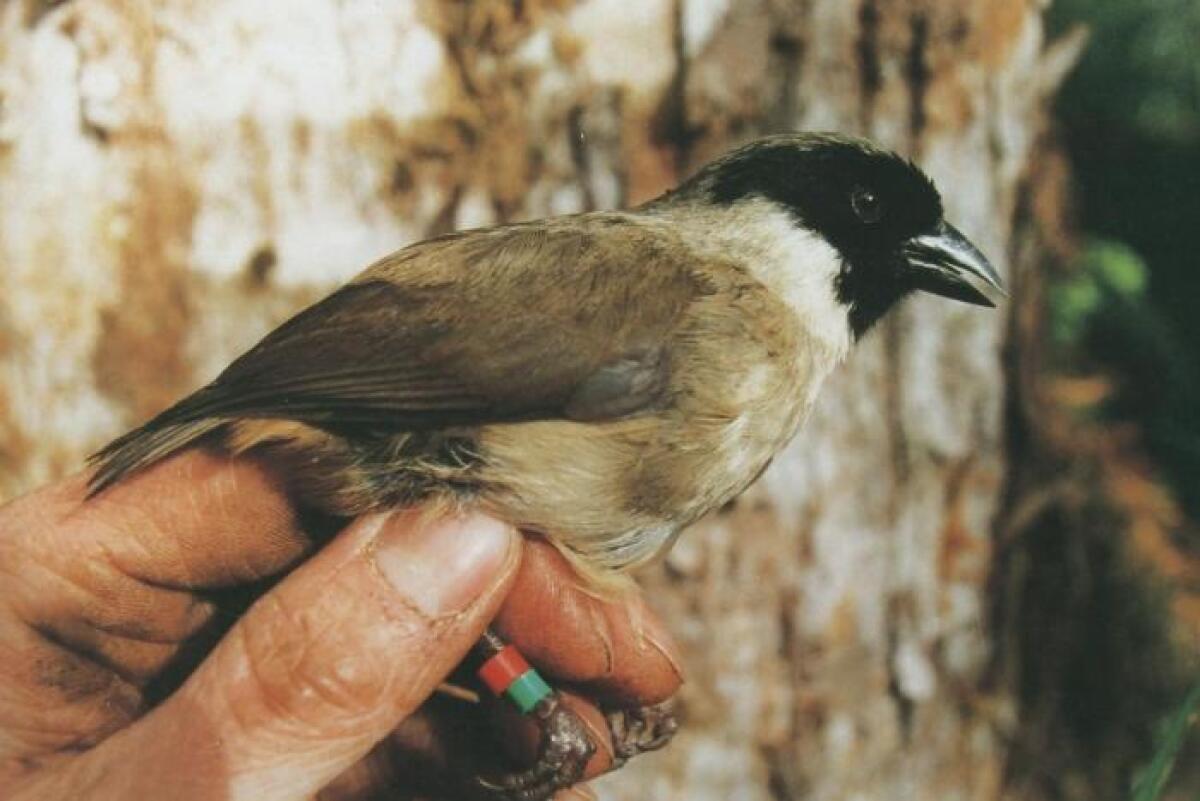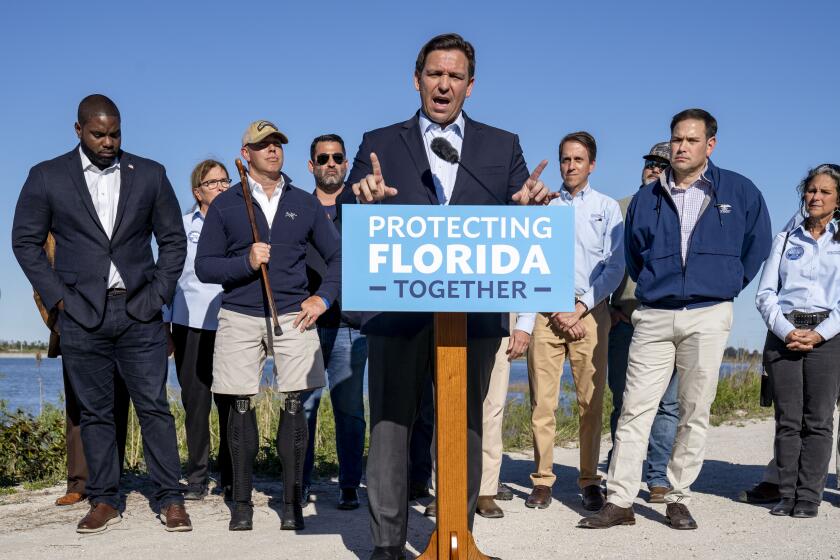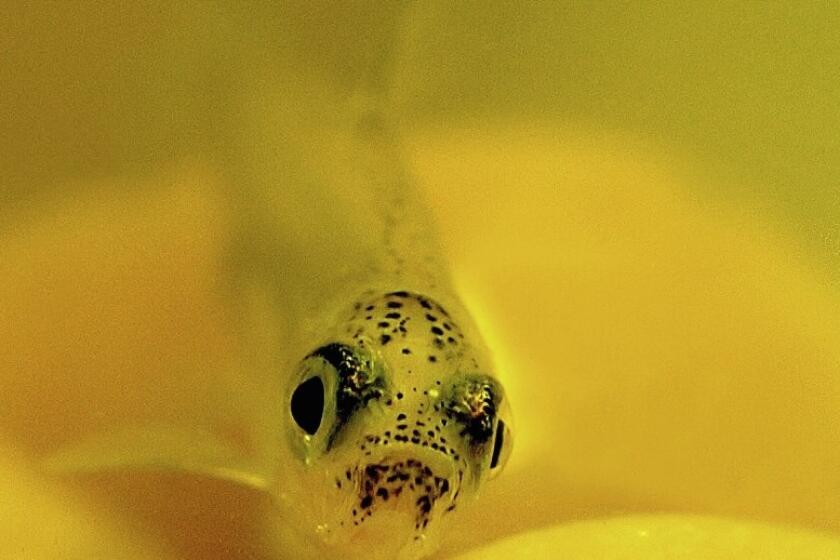Humans have driven 21 more species to extinction. Here’s why we should care

- Share via
The removal of a species from the government’s endangered species list is often a cause for celebration, as it means a plant or animal variety has somehow beaten the odds and recovered from its parlous condition.
That’s not the case for 21 animal species just delisted from the Endangered Species Act by the U.S. Fish and Wildlife Service. They’re being taken off the list because they have moved in the opposite direction. They’ve gone extinct.
The latest list is a slight reduction from the agency’s original proposed delisting of 23 animal and one plant species in 2021; the removals were of a woodpecker that the government isn’t sure has gone extinct, though it hasn’t been seen in the wild since 1944, and a Hawaiian herb for which a suitable habitat has been discovered. But both plainly are on borrowed time.
It’s heartbreaking that Hawai‘i is known as the ‘extinction capital of the world.
— Maxx Phillips, Center for Biological Diversity
“My heart breaks over the loss of these 21 species,” Noah Greenwald, endangered species director at the Center for Biological Diversity, said after the agency’s announcement on Oct. 16. “These plants and animals can never be brought back. We absolutely must do everything we can to avert the loss of even more threads in our web of life.”
The species named by the government mostly aren’t among the best known or most widely beloved. They include a fruit bat from Guam, eight small Hawaiian birds, two fish species formerly found in Texas and Ohio, and eight varieties of mussel last seen in the Southeast. For the most part, they don’t have the pizzazz of other formerly endangered species that were brought back from the brink by focused efforts at preservation, such as the bald eagle.
Get the latest from Michael Hiltzik
Commentary on economics and more from a Pulitzer Prize winner.
You may occasionally receive promotional content from the Los Angeles Times.
But that doesn’t mean their disappearance is unimportant. The listed extinctions are all due to human activities in one form or another: global warming that shrank the species’ habitats, pollution, overexploitation, and the introduction of alien invasive species that helped kill them off. They are, to cite a common trope, canaries in the coal mine that clue us in to the effect — almost always negative — of our actions on the world we live in.
Conservatives and business lobbyists commonly dismiss concern about the fate of ostensibly unimportant species as pointy-headed liberal hand-wringing.
A good example is the disdain shown by Central Valley farmers and their political mouthpieces for the unassuming delta smelt, a tiny endangered fish they blame for mandated diversions of the water they use for irrigation into rivers and streams to preserve the ecosystem.
(As president, Donald Trump groused that the government was taking the growers’ water and “shoving it out to sea ... to protect a certain kind of three-inch fish.”)
Blindly protecting investments in coal and oil without taking account of the changing world is a formula for impoverishment — environmentally, socially, and especially financially.
“We care about the delta smelt not entirely for itself, but because its health is an indicator of the overall health of the delta ecosystem,” I wrote in 2018 — “and the signal it has flashed is alarming.” In case growers don’t get the message, it’s that if the delta ecosystem entirely collapses, their commercial fortunes will go with it.
As Charles P. Pierce of Esquire puts it, obscure creatures like those on the latest extinction list “don’t make good TV commercials. ‘Save The Upland Combshell’ makes for a terrible bumper sticker.” (The upland combshell is one of the disappeared mussel species.)
Humans’ selective solicitude for endangered species was well illustrated by George F. Will in a 2017 Washington Post column inveighing against the Endangered Species Act. It was headlined, “Federal power creeps its way toward controlling ... spiders?”
Will’s complaint was that the Interior Department had placed the fate of the Bone Cave harvestman, an endangered blind spider, ahead of the right of Texas rancher John Yearwood to do what he wished with his land, on which the spider was found. How dare they, Will wrote, given that the ranch had been in Yearwood’s family since 1871?
Never mind that, as Texas Monthly reported, the spiders are thought to have occupied their habitat since “before the last ice age,” which one might think had given them superior rights to the property than those johnny-come-lately Yearwoods.
Will showed nothing but contempt for the spiders. No one asked the spiders what they thought of George F. Will, but if they could speak it’s a fair bet that they wouldn’t like him any more than he liked them. (The effort to quash the Interior Department’s effort to save the spider failed in federal court; the creature remains on the endangered list.)
Hiltzik: Interior Secretary Bernhardt’s previous job raises questions about a deal for his ex-client
Westlands Water District is about to get a rich deal from Interior Secretary David Bernhardt, its former lawyer.
As is almost always the case, the protection of endangered species is an issue in which economic interests get disguised as political talking points.
Trump’s interior secretary, David Bernhardt, was his administration’s severest critic of the Endangered Species Act. In a 2018 op-ed for the Washington Post, he announced that his agency was preparing to bring the act “into the 21st century,” chiefly by restricting the Interior Department’s authority to designate species as “endangered.” (Bernhardt was deputy secretary then; he was appointed to the top spot the following year.)
What Bernhardt didn’t mention was that, prior to joining the administration, he had sued the government to roll back the Endangered Species Act as a lawyer for the giant Westlands Water District. As I wrote, “the application of the Endangered Species Act to future water projects is of profound interest to Westlands and other agribusinesses like it, not to mention other industries Bernhardt represented as a private attorney.”
Dismissing the extinction of species as no big deal merely demonstrates human narrow-mindedness and ignorance about our impact on the world.
Species of gambusia like the one designated extinct in the government list are crucial for controlling mosquitos, which are more than just a summertime nuisance but a vector for disease. It died off, according to the Center for Biological Diversity, because of “water overuse that depleted groundwater and spring flow.” It was last seen in 1983.
The eight extinct Hawaiian bird species died off in part because “their forest habitats were razed by development and agriculture,” the center observed.
The right-wing campaign to demonize the tiny delta smelt so Big Ag can get more water continues, ignorantly
Did this matter for humans? Consider that the deadly Maui wildfires that dominated the news last summer were caused in part by the clearing of native vegetation to allow agricultural cultivation. Global warming has allowed mosquitoes to spread in Hawaii and move into elevations where they become threats to native birds.
“Of all the species listed as endangered or threatened in the United States, nearly a third are Hawaiian,” Maxx Phillips, the Center’s Hawaii director, said in 2021. “It’s heartbreaking that Hawai‘i is known as the ‘extinction capital of the world.’”
Humans are overwhelmingly responsible for the introduction of invasive species that can quickly exert dominion over native flora and fauna, reducing ecological diversity and undermining human commercial and industrial activities. That includes the quagga and zebra mussels, which hitched rides on oceangoing ships from their original habitats in Eastern Europe to reach the Great Lakes in the 1980s and the West Coast by 2008, destroying freshwater mussel farms along the way.
Eventually they started clogging intakes of water treatment and power plants and interfering with recreational boating. In the Great Lakes, they’re blamed for outbreaks of avian botulism that have killed tens of thousands of birds and for a general increase in water pollution. Keeping them under control already costs $500 million a year; an analysis by UC Riverside estimates that if they become established in Lake Tahoe, they’ll cost the tourism sector there $22 million a year.
The lesson is that we can ignore the interconnectedness of biological life only at our peril. Weighing the extinction of species through our careless stewardship of nature’s bounty against the near-term cost of regulation demonstrates human shortsightedness at best, and stupidity and cynicism at worst. When a plant or species disappears for good in these modern times, it leaves behind a warning to our own species.
More to Read
Get the latest from Michael Hiltzik
Commentary on economics and more from a Pulitzer Prize winner.
You may occasionally receive promotional content from the Los Angeles Times.













